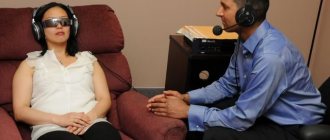Obsessive-compulsive disorder is a disorder characterized by obsessive thoughts. Also known as obsessive-compulsive disorder and obsessive-compulsive disorder. Depending on the general picture of the disease, it can take a progressive, chronic or episodic form.
People diagnosed with obsessive-compulsive disorder, regardless of their wishes, experience various disturbing and sometimes frightening thoughts, medically called obsessions. A person susceptible to this condition makes attempts to get rid of anxiety, which was caused by obsessive thoughts, with the help of equally obsessive actions - compulsions. The Yale-Brown scale is used to diagnose this mental disorder.
Common types of obsessions
In medicine, there are several obsessions characteristic of the disease:
- fear of various kinds of danger (fear of being robbed, harming your family),
- fear of becoming infected (viruses, dirt, pesticides),
- anxiety due to lack of order, asymmetry and precision,
- various imaginations, obsessive thoughts about sex.
Against the background of haunting thoughts, a person resorts to compulsion and obsessive actions. This allows you to temporarily reduce tension, anxiety, and get rid of obsessive thoughts.
Factors and reasons
It is difficult to name the main cause of OCD syndrome, since both physiological and psychological factors are responsible for such an unhealthy disorder of the nervous system:
- Genetic predisposition.
- Infection with group A streptococcal infection in childhood, which provokes inflammatory processes and leads to dysfunction of the basal ganglia. In medicine, this phenomenon is called pediatric autoimmune neuropsychiatric disorder. Also, the cause of OCD can be the body’s immunological reaction to various pathogenic microflora (viruses, bacteria, fungi).
- In patients with this syndrome, certain areas of the brain have unusual activity. Such people suffer from increased aggression and sexual preoccupation. They are characterized by bodily discharge. These disorders are caused by decreased activity of serotonin and glutamate.
- Constant avoidance. A person diagnosed with OCD is in fear and tries to avoid danger. To get rid of obsessive thoughts about her from his head, he begins to perform compulsive rituals that eliminate anxiety. The risk group includes people who have experienced severe stress: a change of job, a break in a relationship with a loved one, or severe mental and physical fatigue.
- Obsessive-compulsive disorder develops in people who have suffered serious psychological trauma: violence, serious illness, death of a loved one, moving to a new place of residence, problems in the family or at work.
Symptoms of the development of obsessive-compulsive disorder
Regardless of the cause of obsessive-compulsive disorder, symptoms develop according to the same principle, but stereotypical movements may differ, as well as obsessive ideas and thoughts.
OCD may present with the following types of symptoms:
- Obsessive thoughts
. They arise regardless of the desire of the person himself, but are recognized by him as his beliefs, ideas and even images. They constantly invade consciousness and repeat themselves stereotypically, dominating others. A person cannot resist such a thing. Examples of such thoughts can be individual words, phrases, poems. Sometimes their content is obscene and contrary to the character of the person himself. - Obsessive impulses
. An irresistible desire to immediately carry out some action that is meaningless and sometimes shocking. For example, a person suddenly has a strong desire to swear or call someone names in a public place. He cannot control this impulse, no matter how hard he tries. Often these actions are carried out by people whose upbringing does not allow them to do this, but, nevertheless, obsessions force them. - Obsessive thoughts
. A person begins to think about some ridiculous situations, makes arguments and rejects them, getting stuck in this internal discussion. These may be doubts that relate to performed or unfulfilled rituals, while trying to resist the internal need for these actions. - Obsessive images
. A vivid presentation of violent scenes, perversions and other impressive pictures that are not at all consistent with upbringing and religious prejudices. - Obsessive doubts
. Various types of uncertainty about the correctness or completion of certain actions, constantly emerging in the memory and interfering with normal life activities. Symptoms persist even after doubts can be dispelled and the person becomes convinced that they are groundless. - Obsessive phobias
. Fears that arise for no reason and are meaningless in their essence. Their character is represented by dozens of possible options that are observed in OCD. These could be hypochondriacal phobias, manifested in the fear of contracting a terrible infection or becoming seriously ill. - Obsessions with pollution (mysophobia)
. A person is constantly wary of getting dirty, poisons, small needles or other things entering the body. They manifest themselves in special rituals that are needed to protect themselves. Special attention is also paid to hygiene and constant checks of cleanliness. Such people often avoid physical contact, and some are even afraid to leave the room.
To be diagnosed with obsessive-compulsive disorder, certain conditions must be met. First, obsessive and/or compulsive symptoms must have been present for at least 2 weeks. They must cause distress and disrupt human activity, and also meet the following requirements:
- Obsessive thoughts and ideas should be regarded as one’s own, not external;
- There is at least one thought or action that the patient tries to resist;
- Performing an action does not bring proper satisfaction;
- Thoughts or ideas are periodically repeated in a stereotypical manner.
Important! OCD symptoms can have a significant impact on a person's life. He can isolate himself from the outside world, lose his previous connections, family, and job.
Psychotherapy
This is a classic method that is used for milder cases of the disease.
Of all the psychotherapeutic methods, the best effect in treating this syndrome is provided by:
- cognitive behavioral psychotherapy,
- short-term strategic psychotherapy,
- EMDR therapy,
- hypnosis.
Psychotherapists claim that this method of treatment helps in 75% of cases.
Cognitive behavioral psychotherapy
This technique is developed according to the type of training for each patient individually. To determine the severity of the disease, the psychotherapist uses various tests and scales. The doctor also monitors all the patient’s OCD symptoms.
After this, the specialist applies the technique of exposure therapy. The patient is exposed to fear from a list of symptoms and his condition and actions are observed. In the intervals between such sessions, the patient must independently perform work aimed at combating this fear.
There is another effective technique - imaginary representations. The patient and therapist create short stories in which they talk about obsessive thoughts and actions. The conversation is recorded on a voice recorder, after which the patient listens to it. This approach allows him to dose out his experiences and learn to deal with them.
Short-term strategic psychotherapy
The goal of this technique is to achieve a therapeutic effect as quickly as possible without studying the causes of the syndrome.
First, the doctor gains the patient’s trust in order to convince him of the effectiveness of this treatment method. Then he develops special exercises for the patient to eliminate obsessive states.
Usually, 10 sessions, which last from 20 to 60 minutes, are enough for complete treatment. This therapy helps treat even the most chronic and severe forms of the syndrome.
EDMR therapy
This therapy is based on reducing sensitivity and changing eye movements. This is a very effective technique that helps reduce the intensity of emotional experiences and speed up the natural process of processing information.
In addition to eye movements, EDMR therapy includes sounds (alternating between the right and left ears) and tapping.
Session duration is 1-1.5 hours, number from 2 to 16 sessions. This treatment method is contraindicated for patients suffering from epilepsy and psychotic conditions.
The therapeutic technique works well to treat OCD in people who have suffered a terrorist attack, war, car accident and violence.
Hypnosis
It is one of the most effective methods of treating obsessive disorders.
The patient's body is put into an artificial state of drowsiness or sleep, which leads to inhibition of consciousness and unconscious execution of various commands.
The main goal of hypnosis is to cure neurosis. There are two methods of hypnotic therapy:
- Directive persuasion. The goal of such therapy is to change the patient's thoughts and actions, which helps him overcome fear. The person is also introduced to new behavior options that replace obsessive actions.
- Indirect beliefs. New thought patterns are instilled in the patient, which are reinforced at both the conscious and unconscious levels.
- Methods of regression, progression and confusion are used to distort time and embed the necessary suggestions. This approach allows the patient to quickly and painlessly cope with OCD syndrome.
In most cases, all of the above methods help the patient get rid of obsessive-compulsive disorder forever.
Treatment of OCD
Patients with obsessive-compulsive disorder (OCD) experience repetitive, intrusive thoughts (obsessions, images) and/or repetitive patterns of behavior (compulsions, rituals) that last at least one hour per day and significantly affect the person's normal level of functioning. Intrusive thoughts (images) cause noticeable anxiety and anxiety, and patients often describe their compulsions (rituals) as attempts to reduce the severity or neutralize these disturbing thoughts. Common obsessions include fear of contamination, fear of harming oneself or others, intrusive violent images, repeated forbidden or deviant sexual thoughts, the need to preserve objects of perceived value, thoughts of sacrilege or morality, a need for symmetry, and excessive concern about appearance. Examples of compulsions performed in response to obsessions include excessive hand washing, ritualized bathing or testing, mental rituals, the need to repeat actions, reread text, etc.
Obsessive-compulsive disorder (OCD) was once thought to be extremely rare, but recent epidemiological studies have shown that it is the fourth most common mental disorder (after substance abuse, specific phobias and depression). OCD is usually a chronic condition when it is not diagnosed on time or is not diagnosed properly. The basis of treatment: cognitive behavioral therapy, pharmacological treatment and physical therapy. The use of clomipramine in the 1960s and then the introduction of serotonin reuptake inhibitors (SSRIs) in the 1980s represented important milestones in the pharmacological treatment of OCD. Despite effective treatments, many patients demonstrate only a partial response or resistance to available medications. Treatment-resistant OCD is one of the few diagnoses in modern psychiatry for which invasive neurosurgical procedures remain part of the treatment armamentarium.
Men typically have an earlier onset of OCD than women. Susceptibility to OCD is at least partly genetic. Additionally, first-degree relatives of OCD sufferers have an increased risk of developing the disorder. Recent research has suggested that different types of OCD symptoms (e.g., intrusive thoughts about cleanliness, rather than hoarding obsessions and compulsions) may represent dissociable, albeit overlapping, syndromes, and may reflect different genetic underpinnings.
Neuroimaging studies have found increased blood flow and energy consumption in the orthofrontal cortex, striatum, and thalamus in patients with OCD. These brain regions are components of the corticostriatal-thalamo-cortical (CSTC) neuronal network. The CSTC circuit consists of parallel pathways that receive cortical information, process it, and project back to the cortex via the thalamus. The direct pathway through the CSTC network activates the excitatory effect and is thought to modulate the initiation and persistence of certain behaviors, while the indirect pathway modulates the termination of these behaviors. The current model of OCD proposes that increased activity in the direct pathway relative to the indirect pathway leads to disinhibition of the thalamus, creating a self-repairing overactive circuit between the thalamus and orbital cortex that drives OCD symptoms. Patients who respond to standard treatments demonstrate correction of hyperactivity in the network(s) of CSTC neurons. Several studies have demonstrated decreased orbitofrontal, caudate, cingulate, and thalamic metabolism in responsive patients.
The effectiveness of behavioral and cognitive behavioral therapy in the treatment of OCD has been confirmed in more than 30 studies. The best proven behavioral strategy is exposure prevention and response (ERP). During ERP, stimuli that cause restlessness, anxiety, and compulsions are systematically presented in a controlled environment, and patients are able to avoid common compulsions. The use of ERP is problematic in some patients (especially those who are reluctant to exercise, those who experience anxiety associated with exposure to noxious stimuli, or those with isolated obsessions). When administered correctly, CBT/ERP is an effective treatment modality and may be considered a first-line treatment for some patients.
Clomipramine, a tricyclic antidepressant that is the most specific serotonin reuptake inhibitor, was first demonstrated to be effective in treating obsessive-compulsive symptoms in uncontrolled studies in the 1960s. The introduction of selective serotonin reuptake inhibitors (SSRIs) in the 1980s represented the next major pharmacotherapeutic advance in the treatment of OCD. Due to their more benign side effect profile, SSRIs are now considered first-line pharmacotherapy for OCD in most cases, although clomipramine continues to be widely used in OCD treatment. The use of SSRIs and clomipramine in the treatment of OCD differs from the treatment of depression and other anxiety disorders: firstly, higher doses of drugs are required, and secondly, the weakening of OCD symptoms tends to have a gradual effect lasting at least 10-12 weeks.
Treatment-resistant OCD remains a relatively common problem in the treatment of this mental disorder. Treatment failure is typically defined in OCD research as failure to achieve the following: 1) a 25 or 35 percent reduction in Y-BOCS score; 2) total Y-BOCS score less than 16; and 3) the clinical global improvement rating of “much improved” or “much improved” after at least two months of SSRI monotherapy remains unchanged.
Clomipramine, which retains some norepinephrine reuptake inhibitory (NRI) effects relative to SSRIs and whose metabolite desmethylclomipramine has significant NRI activity, appears to be a more effective treatment for OCD than more selective agents (SSRIs). The possible contribution of NRI to the efficacy of clomipramine has led to several trials of the dual-acting serotonin-norepinephrine reuptake inhibitor venlafaxine in both treated and untreated patients. An open-label trial of venlafaxine, both in the treatment of common forms of OCD and in the treatment of resistant forms of OCD, showed high effectiveness compared to SSRI drugs. One study found that the 5HT2A agonist mirtazapine may accelerate the effects of paroxetine on OCD symptoms. Mirtazapine was also effective as monotherapy for OCD. Intravenous clomipramine and intravenous citalopram have been shown to lead to significant improvement in symptoms in some treatment-resistant patients.
The apparent effectiveness of both typical and atypical antipsychotics in Tourette syndrome motivates research into dopamine antagonists as augmentation therapy for OCD. Early studies showed that the benefits of antipsychotics are greatest in patients with OCD and comorbidities, but more recent studies show benefits of antipsychotics in patients with tics. Fewer studies have examined opioid augmentation therapy. Morphine given once weekly has been shown to be effective in the treatment of treatment-resistant OCD in one double-blind study, and administration of the opioid agonist tramadol hydrochloride has also been shown to reduce OCD symptoms. Drugs that manipulate glutamate neurotransmission are particularly interesting candidates for pharmacotherapy of resistant OCD, as they represent a new perspective distinct from the focus on monoaminergic modulatory systems.
Neurosurgical approaches to refractory OCD have recently been reviewed. The effectiveness of neurosurgical ablative techniques is further emphasized by several reports of reductions in obsessive-compulsive symptoms following neurosurgical ablation of epileptic foci. The development of deep brain stimulation (DBS) techniques, which can reversibly manipulate the activity of specific brain circuits, has attracted growing interest in recent years as a possible treatment for OCD. Finally, the use of electroconvulsive therapy (ECT), transcranial magnetic stimulation (TMS), and vagal nerve stimulation (VNS) have been studied as less invasive treatments than neurosurgery. None of these therapies have demonstrated significant effectiveness in the limited studies conducted to date.
Drug therapy
Treatment with medications is used if psychotherapy is powerless.
The patient is prescribed effective anti-resistant drugs:
- antidepressants,
- other psychotics,
- drugs containing lithium,
- Inositol with increased dosage,
- setrons,
- Memantine, Afetylcysteine and other drugs of similar action,
- Omega-3.
Antidepressants
You can fight depression and reduce anxiety with the help of SSRI antidepressants. They inhibit serotonin reuptake. The best drugs in this group include:
- Fluvoxamine. It has a calming effect, improves mood and normalizes the functioning of the autonomic system. This drug is prescribed for anxiety and depression. It is not recommended to take this drug yourself at home, since it has a number of side effects: nausea, vomiting, dizziness, abdominal pain, anorexia and insomnia.
- Sertraline. Helps cope with panic attacks, depression and obsessive-compulsive disorder. Contraindicated for epilepsy, liver and kidney failure, during pregnancy and for children under 6 years of age.
- Fluoxetine. A complex action drug that eliminates feelings of anxiety and deep depression in OCD syndrome. It has a number of side effects: headaches, weakness, asthenia, increased excitability.
- Paroxetine. An effective drug that helps cure neurosis. It has the same side effects as the drug Fluvoxamine. Additionally, the risk of developing suicidal thoughts increases in both adults and children. Therefore, it is contraindicated to use it independently at home without a doctor’s prescription.
Tip 2: How to resist OCD rituals
If you have obsessive-compulsive disorder (OCD), there are many ways you can help yourself. One of the most powerful strategies is to eliminate the compulsive behaviors and rituals that keep the compulsions going.
Don't avoid your fears
It seems smart to avoid situations that trigger obsessive thoughts, but the more you avoid them, the more scared you feel. Instead, expose yourself to the OCD triggers, then try to deal with the impulse to complete the compulsive ritual of seeking relief or put it off. If resistance is too difficult, try reducing the amount of time you spend on the ritual. Each time you expose yourself to the triggers, your anxiety decreases and you begin to realize that you have more control (and less fear) than you thought.
Refocus your attention
When you encounter OCD thoughts and impulses, try shifting your focus to something else.
- You can start a workout, jog, walk, listen to music, read, search for something on the Internet, play on the computer, make a call or start knitting. The important thing here is to commit yourself to doing something you love for at least 15 minutes to put off your usual response of obsessive thoughts or actions.
- At the end of the delay period, re-evaluate the momentum. In many cases the momentum is no longer as strong. Try saving for a longer period. The longer you delay an impulse, the more likely it is to change.
Anticipate OCD impulses
By anticipating your compulsive impulses before they arise, you can help yourself mitigate them. For example, if your compulsive behavior includes making sure all doors are locked, windows are closed, or appliances are turned off, try closing a door or turning off an appliance, paying extra attention the first time.
- Create a strong internal image and then take a psychological note. Say to yourself: “The window is closed now” or: “I see that the stove is turned off.”
- When the impulse to check arises later, it may be easier for you to relabel it as “just an intrusive thought.”









